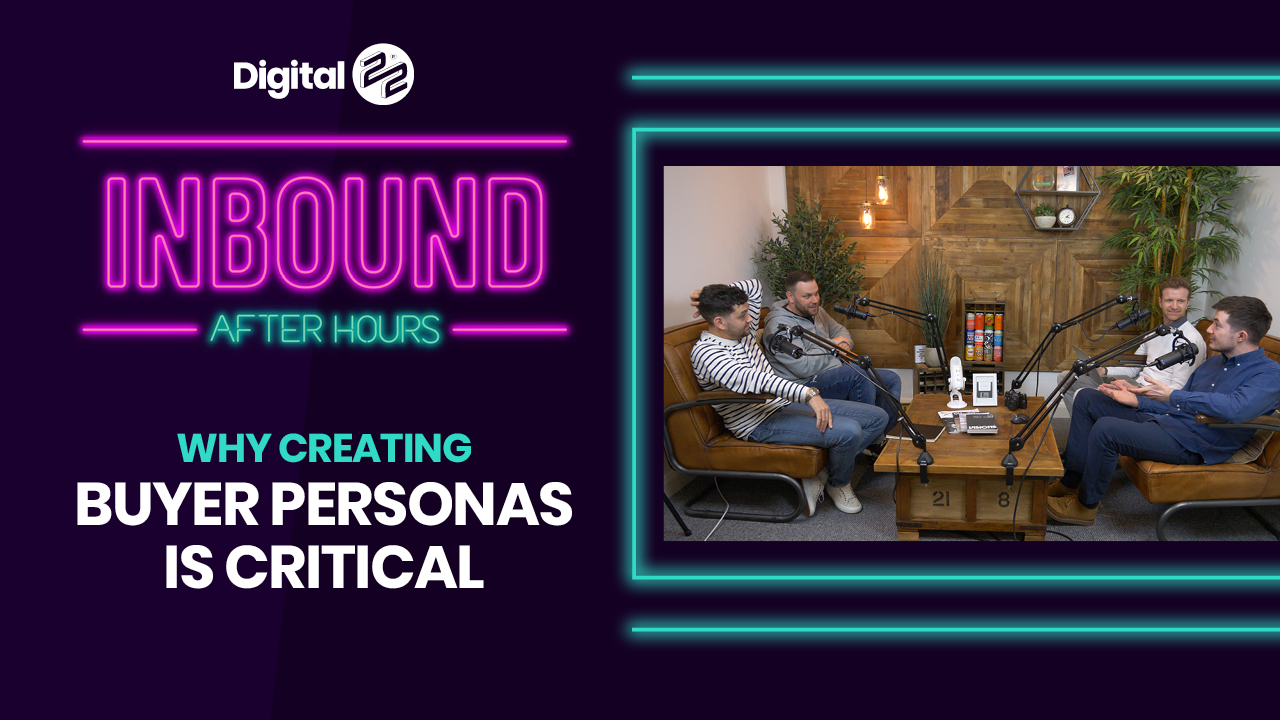Inbound marketing - it doesn’t make much sense to try doing it without using personas. Without a ‘character’ to target, your helpful, relevant content will be up inbound creek without a paddle.
How come inbound marketing personas are so important to the inbound process? I’ll tell you.
- What is an inbound marketing persona?
- Who can use them?
- What are the goals of using personas?
- How do you create a persona?
What is an inbound marketing persona?
An inbound marketing or ‘buyer’ persona is a semi-fictional representation of a certain type of customer. They’re created by mixing real data, market research and a few educated guesses about your customers.
A person is a real jumble of things: motivations, pains, demographics, behaviours, goals and opinions. It’s like watching a film. The more detailed characters are, the more we're able to connect with them and understand their motivations.
Who can use them?
Preeeeetty much anyone can use them (I mean, you should probably leave the work to an experienced inbound agency). But the important part isn’t really ‘who’ uses inbound marketing personas, but ‘how’ they’re used.
When using personas, you’re focusing all your work on a certain type of person. This means you can get rid of the irrelevant information, which makes for tighter, more accurate content production. If you have a persona in mind, you'll be able to keep their challenges, pain points and ideals in mind too. Each piece of inbound content you create will be able to answer these issues.
Think of it like this:
Right people, right time, right content
A persona helps us to target the right person with the right content (leave the ‘right time’ to the other inbound processes like email segmentation and buyer journeys).
Creating inbound marketing personas helps us when creating that content. We know who we’re speaking to so we have the info on how to contact them, what to say, what to reference and even the tone of voice we should use.
It boils down to this: A persona provides context to the narrative. Like a compass for a ship on a starless night, they give us direction. Unless they have GPS - it’s an old reference, I briefly forgot I wasn’t in Titanic.

|
Personas are at the core of everything we do. Especially in terms of content. They’re not necessarily the people you deal with day-to-day - they’re the people you want to deal with. |
If you’re using a dedicated CRM in your marketing efforts, such as HubSpot, having personas helps you to segment your contacts, which makes them, well, easier to contact.
For example, instead of writing the same emails for everyone (which might not resonate with them all), you can tweak these emails for the different personas. They can all say the same thing, but these small persona-specific changes can help your click-through rates increase.
This means you can be accurate in how and when you target your messages. Bullseye.
What are the goals of using personas?
Everything you create should be embedded within the persona framework. It’s all about solving their problems and creating a personalised kind of trust between a business and a client.
Because a persona is used during every part of the inbound process, your goals that include them could be wide-ranging. The main goals of using personas are:
-
Developing and maintaining a good standard of targeted content, so that your content marketers can become experts at identifying what will work and what won’t.
-
Targeting consistently, especially in the work of strategists, marketers and SEO experts. Without a persona to guide them, their efforts might be less effective.
-
Refine your marketing campaigns towards these personas time and time again.
-
Gain in-depth, specialist-level knowledge of a specific industry so pain points can be identified and solved quickly and accurately.
If you want to hear it from our in-house experts, check out this video:

How do you create a persona?
Gathering research
Inbound marketing personas are created by collating information from three places: research, customer surveys and historical data. There are some great ways you can gather this information before it comes to the creation stage.
This is a bit like Dr. Frankenstein gathering body parts to turn into his famous eloquent monster but, you know, less messy and illegal.
For example:
-
Form fields on your website can be used to capture important data - things like age, job title or industry.
-
Segment your contacts database to discover how people first discovered your content. Using this, you can figure out what kinds of content your personas prefer.
-
If you have repeat clients, interview them or have them fill out a survey. These are great ways of getting more personalised information to create your personas with.
-
Ask your sales team and any customer-facing role about the kind of customers they interact with and what the interactions usually concern. Do they see any general connections between customer types?
There is a difference between a persona and a target audience. A target audience is based on demographic data. A persona takes that goes deeper. |

|
Collate your data
It’s time to distill this data into working personas. Work through your research to identify any commonalities and patterns. There are four parts to this step:
-
Fill in the basic information. A very simple step - we’re talking age range, job title and the more complex things such as background (are they family-oriented? How long have they been in a specific industry?). You can also include identifiers such as their demeanour and where they are in their organisation’s hierarchy.
-
Compile motivations. This is all about the ‘why’. Why are they wanting a certain product or service? What are they trying to solve?
-
Work with your sales team to prepare for future conversations with a persona. In this step, you should go over buzzwords, actual quotes and any emotional language to identify the pain points and how they like to be treated. This is a good point to go over any objections someone might have ranged with your services. If you find similarities, you’ll be able to work on creating a response.
- Create bespoke messaging for each persona. This includes creating ‘elevator pitch’ style descriptions of your products or services and tweaking them to suit your different personas, depending on their level of knowledge, preferences and pain points.

|
A pain point becomes symbolic. It represents hundreds of different things. Everyone has their own angle. |
Personas help everyone in your organisation - the social media team, marketers, upper management and any others to speak the same way to the same people. It helps to build trust and protects against any miscommunications.
Finally, give them a name that summarises who the persona is. Say you’re selling toasters. How about Toaster Expert Tom? Brown Bread Brian? The choice is yours. And remember this bit of wisdom from Mark:
Personas are constantly evolving. If you find something out - write it down and add it in. |

|
So, we've just spoke about why inbound marketing personas are so important. There's much more to know, though. If you’re looking to further develop your knowledge of inbound marketing personas, download our new guide ‘Inbound Marketing 2.0’.
Explore the best knowledge on inbound personas
‘Inbound Marketing 2.0’ is full of handy advice that explores the latest ideas and trends in inbound marketing. If you’re new to the method or simply want to improve on your knowledge, this is the guide for you.
You’ll be able to discover new information on inbound statistics, buyer journeys, the all-important flywheel and of course, how to truly nail your inbound marketing personas.
If you’d like to learn all this and more, click the link below to download your free copy.
Real Growth. Real Impact.
'Should I use HubSpot?' 32 fundamental reasons why you should
21 cost-effective marketing campaigns you can create right now
Breeze: Everything you need to know about HubSpot's powerful AI
INBOUND 24 learnings and updates
Google Search API leaks: All you need to know [LIVE BLOG]
The top 6 marketing challenges of 2024
Inbound vs outbound marketing: What's the difference?
See why enterprises choose Avidly
Let’s build your HubSpot success story
Compelling final call to action - with accompanying link to Contact page





![Google Search API leaks: All you need to know [LIVE BLOG]](https://www.avidlyagency.com/hs-fs/hubfs/cloud.jpg?width=400&height=225&name=cloud.jpg)


